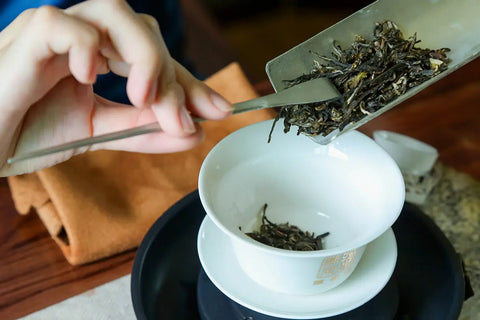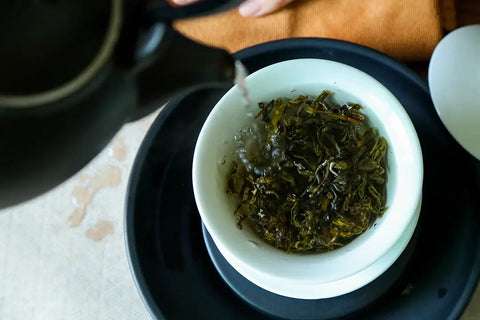Ultimate Guide of Awakening Pu erh Tea
Pu erh tea is like a beautiful princess, with its own language that requires us to understand and appreciate with our hearts. To reveal the full beauty of Pu erh tea's life, we must pay attention to every detail, and "awakening" the tea is one such crucial aspect. Choosing the most suitable method to gently awaken the tea is essential. When we awaken its inner qualities, the tea, in turn, provides us with an atmosphere of clarity and elegance, offering us a chance to awaken our minds and spirits.

Bestsellers
What Is "Awakening" Tea?
Awakening tea involves reviving dormant or sealed tea leaves through contact with air and moisture, allowing the leaves to breathe naturally and rejuvenate their essence. For Pu'er tea, with its unique character and content, the awakening process usually includes two aspects: awakening before brewing, known as "dry awakening," and awakening during brewing, known as "wet awakening."

Why Is Dry Awakening Important For Pu'er Tea?

Dry awakening changes the storage conditions of Pu'er tea to awaken its quality and concentrate its aroma. Newly opened Pu'er tea can't fully exhibit its deep and rich flavors when brewed immediately. Through the meticulous process of awakening, the flavor of Pu'er tea becomes more mellow and pure. Every tea enthusiast has their understanding of dry awakening Pu'er, so there are various methods and procedures for it. Below are some commonly used ways.
The first step is to remove the packaging and loosen the tightly compressed Pu'er tea. Newly compressed Pu'er tea is usually tight. Use a tea needle or tea knife to loosen it, controlling the angle and strength carefully. For tea cakes, start loosening from the middle groove; for manually compressed cakes, begin from the side. For tea bricks, cut from the side, which makes it easier to split into two pieces and then into smaller chunks. Tuo tea, typically tightly compressed, can be loosened from the edges or sides. Try to keep the leaves intact, following their natural pattern. You can also use steam to loosen tea cakes, placing them over a pot of boiling water. The steam softens the cake, preserving the integrity of the leaves. For older teas, the process is known as "picking the tea," as old teas are usually looser, and the leaves can easily fall apart with gentle touching.
The second step involves ventilating the tea to allow the leaves to breathe naturally and dispel any unwanted odors. Spread the loosened Pu'er tea in a clean, shaded area for ample air contact. Cover the tea with cotton paper to prevent dust and avoid exposure to odors or direct sunlight. The humidity of the spreading area should not be too high to prevent the tea from getting damp. The ventilation time depends on the tea's condition: aged and clean teas need two to three days, while freshly processed or musty teas might require one to two weeks to better dispel unwanted odors.
The third step, after several days of ventilation, is storing the Pu'er tea in a ventilated, odorless, and dry awakening jar to allow it to naturally revive. Generally, a lidded purple clay jar is used for storage, as it has good breathability and shields the tea from light and heat, maintaining stable temperature and humidity inside. After placing the tea in the jar, the awakening period is usually one to three months. New purple clay jars may contain earthy and smoky smells, which can affect the tea's quality. They can be prepared by pouring boiling water over and soaking them, repeating the process once or twice a day. After several days, once the jar is fully dry, it's ready to store the tea. Ensure the jar is completely dry before use, as any residual moisture can spoil the tea. To test, place some raw tea in the jar for a day; if the tea doesn't soften, the jar is dry enough for storing the awakening tea. Besides purple clay, other materials like ceramic, bamboo, rattan, or odorless paper boxes or homemade paper bags can be used for awakening, but the choice ultimately depends on the tea.
Through this detailed awakening process, the tea develops a full, rich aroma and taste. Dry awakening Pu'er tea involves loosening the leaves for ventilation, allowing them to breathe naturally and dispel non-inherent flavors like stuffiness or mustiness, thus restoring the tea's essence. Wet awakening is based on dry awakening, using water and temperature to further awaken the tea's nature, enhancing its quality during brewing.
Lao Ban Zhang
What Is Wet Awakening Pu'er Tea?
Wet awakening, also known as moistening or warm soaking, involves the tea leaves coming into contact with hot water, raising their temperature and helping them unfold gradually, fully awakening the tea. This process also removes any dust accumulated during storage and processing, allowing the tea's flavor to be better released during brewing.

Wet Awakening Method
First, warm the teaware with hot water, add the tea leaves, pour in hot water, and discard the water after a few seconds. Generally, raw Pu'er tea requires one moistening, while ripe Pu'er needs two. The degree of moistening, during the entire brewing process, directly affects the tea's inherent quality.
So, when moistening the tea, consider several aspects: Firstly, decide the water temperature based on the dry tea. Lower the temperature for raw, new, or tender teas, and increase it for ripe or older teas. Time control is also crucial; the soaking time should not be too long. If the moistening time is prolonged, too many substances will be released from the tea, affecting the taste of the brewed tea, so quickly pour out the moistening water. Observing the color of the moistening water can help determine the water temperature and soaking time for the actual brewing.
Difference Between Washing and Awakening Tea
For Pu'er tea, although wet awakening and washing are the same process, the significance of wet awakening is greater than washing. Washing is mainly for cleanliness, as tea leaves inevitably accumulate dust during processing. Additionally, the first contact with hot water can cause the fine hairs on the back of the leaves to fall off, making the first brew slightly murky.
Since Pu'er tea leaves and stems are relatively thick, the first brew is insufficient to fully awaken the tea, resulting in a bland taste. Therefore, a second brew is needed to fully awaken the tea, which still tastes somewhat bland, but better than the first. After washing and awakening, the tea is ready to release its bitterness, aroma, sweetness, and aftertaste in the third brew.
Awakening Raw and Ripe Teas
This primarily refers to young teas. As young raw and ripe Pu'er differ in nature, with young raw teas having fewer impurities and ripe teas having a heavier musty taste, raw Pu'er require one moistening with lower temperature water (around 85-90 degrees Celsius) for a quick brew. Ripe Pu'er are moistened one to two times in a purple clay pot with high-temperature water for a quick brew.
Awakening Different Grades of Tea
Generally, during wet awakening, tender teas with more buds should be moistened with lower temperature water; teas with fewer buds require higher temperatures. Spring teas need lower temperatures, while summer and autumn teas need higher temperatures. Imperial grade Pu'er teas are moistened with lower temperatures, while aged bricks and old yellow leaves require higher temperatures.
For aged teas, experienced tea enthusiasts are particularly meticulous about the awakening method. First, place the old tea in a dry purple clay pot and cover it. Use a cast iron pot to boil water and pour it over the exterior of the purple clay pot, then gently shake the pot, repeating the high-temperature pouring and shaking process two to three times for about five to ten minutes, equivalent to giving the old tea a dry steam sauna. The temperature inside the pot awakens the long-dormant old tea, and upon opening the lid, one can smell the tea's deep aroma. Then, moisten the tea inside the pot. This method requires only one moistening for old teas, which are too precious to waste. Then, depending on the characteristics of this particular old tea, control the soaking and pouring time.
Pu'er tea, through these two different awakening methods, better showcases its inner qualities, enhancing the aroma and taste of the tea soup. Of course, these are not the only methods for awakening tea. As long as tea enthusiasts understand the characteristics of Pu'er tea, they can create more ways to awaken the tea, helping it better display its unique traits.
← Older post Newer post →











